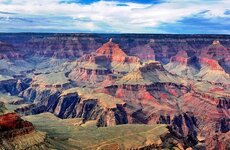DeepseekerADS
Gold Member
- Mar 3, 2013
- 14,880
- 21,733
- Detector(s) used
- CTX, Excal II, EQ800, Fisher 1260X, Tesoro Royal Sabre, Tejon, Garrett ADSIII, Carrot, Stealth 920iX, Keene A52
- Primary Interest:
- Other
Per Mapquest this is 225 miles from Yellowstone - interesting....
Massive crack in earth mysteriously opens up in Bighorn Mountains | GrindTV.com
October 29, 2015 by David Strege
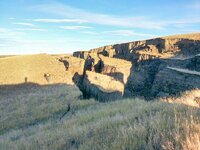
A giant hole opened up on private land in the foothills of the Bighorn Mountains. Photo: SNS Outfitter & Guides
Hunters on a private ranch in the Bighorn Mountains of Wyoming stumbled upon an incredible and mysterious scene: a massive crack in the earth that in some places resembles a mini Grand Canyon.
SNS Outfitter & Guides first reported the anomaly on its Facebook page on Friday, saying it “appeared in the last two weeks on a ranch we hunt in the Bighorn Mountains. Everyone here is calling it ‘the gash.’ It’s a really incredible sight.”
With no earthquakes reported in the area, locals were stunned and at a loss to explain the shift of soil and rocks that left the gaping crack estimated to be 750 yards long by 50 yards wide.
The opening is said to be located 10 miles south of Tensleep, Wyoming, in the foothills of the Bighorn Mountains.
Randy Becker of Casper, Wyoming, was hunting in the area over the weekend and shot and shared amazing photos of the scene, which he called “an awesome example of how our earth is not as stable as you might think. Awesome forces at work here to move this much dirt!!”
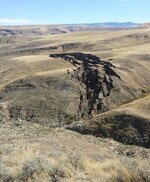
The massive crack is estimated to stretch 750 yards long and 50 yards wide in areas. Photo: SNS Outfitter & Guides
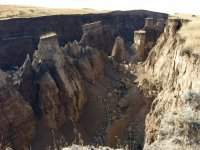
In some parts, the gaping hole appeared to look like a mini Grand Canyon. Photo: Randy Becker
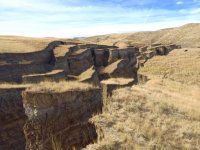
A Wyoming Geological Survey expert called it a “fairly small event given the overall aspect of how big landslides can be.” Photo: Randy Becker
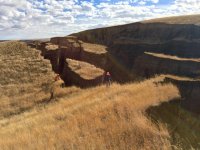
The massive crack in the Bighorn Mountains is “an awesome example of how our earth is not as stable as you might thing,” Randy Becker wrote. Photo: Randy Becker
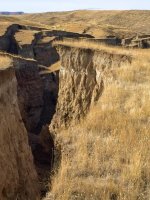
A spring is said to have caused the “slow-moving” landslide in the Bighorn Mountains. Photo: Randy Becker
SNS Outfitter & Guides followed up on Monday with this brief explanation:
“An engineer from Riverton, WY came out to shed a little light on this giant crack in the earth. Apparently, a wet spring lubricated across a cap rock. Then, a small spring on either side caused the bottom to slide out.”
A cap rock is described as a harder or more resistant rock type overlying a weaker or less resistant rock type. So what does that mean?
Seth Wittke, geological manager with the Wyoming Geological Survey in Laramie, explained the event in the Bighorn Mountains as simply a landslide.
“Without getting out there and looking at it, I can’t be positive, but from what I’ve seen on the Internet it looks like a slow-moving landslide,” Wittke told GrindTV in a phone interview.
Regarding the engineer’s explanation about a spring and lubrication, Wittke said, “A lot of landslides are caused by subsurface lubrication by ground moisture or water and things like that, or in this case, a spring.”
Wittke described it as a “fairly small event given the overall aspect of how big landslides can be” and said such an occurrence in the fall in Wyoming is “probably more rare” than it happening in the spring when you’d expect more moisture.
“But they do happen year round, so it’s not out of the ordinary,” Wittke said.
Nevertheless, to the general public, it’s an astonishing event.
So, could the gaping hole continue to grow?
“Yeah, as long as there’s room for it to move it could keep moving,” Wittke said.
Massive crack in earth mysteriously opens up in Bighorn Mountains | GrindTV.com
October 29, 2015 by David Strege

A giant hole opened up on private land in the foothills of the Bighorn Mountains. Photo: SNS Outfitter & Guides
Hunters on a private ranch in the Bighorn Mountains of Wyoming stumbled upon an incredible and mysterious scene: a massive crack in the earth that in some places resembles a mini Grand Canyon.
SNS Outfitter & Guides first reported the anomaly on its Facebook page on Friday, saying it “appeared in the last two weeks on a ranch we hunt in the Bighorn Mountains. Everyone here is calling it ‘the gash.’ It’s a really incredible sight.”
With no earthquakes reported in the area, locals were stunned and at a loss to explain the shift of soil and rocks that left the gaping crack estimated to be 750 yards long by 50 yards wide.
The opening is said to be located 10 miles south of Tensleep, Wyoming, in the foothills of the Bighorn Mountains.
Randy Becker of Casper, Wyoming, was hunting in the area over the weekend and shot and shared amazing photos of the scene, which he called “an awesome example of how our earth is not as stable as you might think. Awesome forces at work here to move this much dirt!!”

The massive crack is estimated to stretch 750 yards long and 50 yards wide in areas. Photo: SNS Outfitter & Guides

In some parts, the gaping hole appeared to look like a mini Grand Canyon. Photo: Randy Becker

A Wyoming Geological Survey expert called it a “fairly small event given the overall aspect of how big landslides can be.” Photo: Randy Becker

The massive crack in the Bighorn Mountains is “an awesome example of how our earth is not as stable as you might thing,” Randy Becker wrote. Photo: Randy Becker

A spring is said to have caused the “slow-moving” landslide in the Bighorn Mountains. Photo: Randy Becker
SNS Outfitter & Guides followed up on Monday with this brief explanation:
“An engineer from Riverton, WY came out to shed a little light on this giant crack in the earth. Apparently, a wet spring lubricated across a cap rock. Then, a small spring on either side caused the bottom to slide out.”
A cap rock is described as a harder or more resistant rock type overlying a weaker or less resistant rock type. So what does that mean?
Seth Wittke, geological manager with the Wyoming Geological Survey in Laramie, explained the event in the Bighorn Mountains as simply a landslide.
“Without getting out there and looking at it, I can’t be positive, but from what I’ve seen on the Internet it looks like a slow-moving landslide,” Wittke told GrindTV in a phone interview.
Regarding the engineer’s explanation about a spring and lubrication, Wittke said, “A lot of landslides are caused by subsurface lubrication by ground moisture or water and things like that, or in this case, a spring.”
Wittke described it as a “fairly small event given the overall aspect of how big landslides can be” and said such an occurrence in the fall in Wyoming is “probably more rare” than it happening in the spring when you’d expect more moisture.
“But they do happen year round, so it’s not out of the ordinary,” Wittke said.
Nevertheless, to the general public, it’s an astonishing event.
So, could the gaping hole continue to grow?
“Yeah, as long as there’s room for it to move it could keep moving,” Wittke said.
Last edited:



